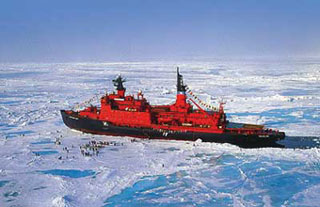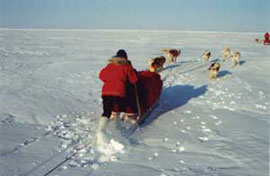The North Pole
The sun is always overhead from Spring to Autumn regardless of the hour of day or night, for the sun only rises once each year and sets once a year here at the Pole. All lines of
longitude1 meet at this point. You can walk around the world in only a few steps. Revisit yesterday as you pass through all the time zones of the world. Every direction you face is South and all winds blow South.

Some places on our planet are so far out of reach that their very
isolation2 has stirred generations of explorers into voyages of adventure and discovery. One such place is the North Pole. At the turn of the last century, voyagers of discovery and adventure set off by sled, balloon, airship and ship for the top of the world - and failed.
Despite many attempts, some of which seem now to have been more foolhardy than brave, it wasn’t until 6 April 1909 that the first expedition reached the top of the world. It was led by Robert E. Peary, who seven years earlier had made the closest approach yet to the Pole in the American Arctic, when he reached 84°17’ North; during that expedition, he lost eight toes to frostbite.
The North Pole attracted only
sporadic3 attention for many years, particularly during the heady years of the space race. But in 1968-69, an expedition led by Wally Herbert is reported to have successfully crossed from Point Barrow, Alaska, over the North Pole, to Spitzbergen by dog sled. This incredible journey took 476 days, and although supported by air drops, it must surely rank as one of the most
arduous4 of recent Arctic journeys.
On April 29, 1978, Naomi Uemura became the first person to complete a solo dog sled journey to the North Pole. Over the previous 12 years, he had accumulated an impressive list of solo mountaineering "firsts" - on February 13, 1984, he disappeared on Mount McKinley, the day after achieving the first winter solo to the summit.

While a few skiers and dog-sleds were challenging the elements on top of the ice, military
vessels5 were fairly common visitors to the North Pole throughout the Cold War period.
One of the most active and
determined6 of recent Arctic adventurers is certainly Will Steger. In 1986, he led an expedition to the North Pole by dog sled, becoming the first confirmed expedition to do so on with no outside support. He must have enjoyed it, because in 1995, he spent another three months on a dog-sled journey from Severnaya Zemlya, Russia, across the North Pole to Canada. Pushing the limits ever further, however, he was
stymied7 by thick fog and unsafe ice in a 1997 attempt to make a solo journey on foot from the Pole to Canada, and had to be rescued. His tales of adventure have been published 3 times in National
Geographic8, and his love of the Polar Regions is apparent in any discussion with him.
Although her 364-mile trip was a stroll in the park compared to some of the other journeys on this page, in 1988, Helen Thayer, at the age of 50, became the first woman to complete an unsupported walk to the magnetic North Pole. She skied and walked for 4 weeks, dragging a sled, accompanied only by Charlie, a dog that she brought for protection from polar bears.
In 2000, Gus McLeod proved that one of my opening statements was incorrect, when he achieved a "first" - he was the first man to fly an open-cockpit plane to the Pole.
With the rapid growth of adventure tourism, it seems like a sure bet that the most remote parts of the world, including the North Pole, will continue to grow in popularity. What was once the exclusive
domain9 of massively-funded government expeditions has now come within reach of many.
The Himalayas
"Himalaya" is a Sanskrit word which
literally10 means "
Abode11 of Snow" - from hima, "snow," and alaya, "abode" - a term coined by the ancient pilgrims of India who travelled in these mountains. For Chinese, Tibetans, Indians, Nepalese, and many of the other inhabitants of the Himalayas, the mountains continue to be the predominant factor in their lives. The beauty of the Himalayas has
lured12 visitors, climbers and trekkers to this region since olden times. 1But more than anything else, the Himalayas represent the awe-inspiring power, beauty, and
grandeur13 of Nature.
The Himalayas, the highest mountain range in the world, extend along the northern frontiers of Pakistan, India, Nepal, Bhutan, Burma and the southern border of China. They were formed geologically as a result of the collision of the Indian subcontinent with Asia. This process of plate tectonics is
ongoing14, and the gradual
northward15 drift of the Indian subcontinent still causes earthquakes.
Lesser16 ranges
jut17 southward from the main body of the Himalayas at both the eastern and western ends.
The Himalayan system, about 2,400 kilometres in length and varying in width from 240 to 330 kilometres, is made up of three parallel ranges - the Greater Himalayas, the Lesser Himalayas, and the Outer Himalayas - sometimes collectively called the Great Himalayan Range.
The Greater Himalayas, or northern range, average approximately 6,000 meters in height and contain the three highest mountains on earth: Mount Everest (8,848 meters) on the China-Nepal border; K2 (8,611 meters, also known as Mount Godwin-Austen, and in China as Qogir Feng) in an area claimed by India, Pakistan, and China; and Kanchenjunga (8,598 meters) on the India-Nepal border. Many major mountains are located
entirely18 within India, such as Nanda Devi (7,817 meters) in the state of Uttar Pradesh.
The snow line averages 4,500 to 6,000 meters on the southern side of the Greater Himalayas and 5,500 to 6,000 on the northern side. Because of climatic conditions, the snow line in the eastern Himalayas averages 4,300 meters, while in the western Himalayas it averages 5,800 meters.
South Pole explorations
It is the coldest, windiest, driest, and highest continent on Earth, so it is a difficult place for people to explore. During the Antarctic winter, in places near the South Pole the Sun is below the horizon for months at a time and it is dark 24 hours a day. Even when the Sun is above the horizon, Antarctica is usually covered by clouds.
Reaching the geographic South Pole was a primary concern of early 20th century explorers. Tentative forays into the Antarctic region had been undertaken by several expeditions during the 19th century, but it was not until the early 1900’s that the Pole itself was considered to be a realistic goal.
Two British expeditions, the "Discovery" expedition of 1902 and the "Nimrod" expedition of 1908, were the first to depart for the continent with conquest of the Pole an expressed purpose. Robert F. Scott’s "Discovery" expedition established an initial "furthest south" record, but competing expedition priorities prevented further progress. In 1908, Ernest Shackleton, a member of Scott’s "furthest south" party, returned to the Antarctic as the leader of the "Nimrod" expedition.
In a
remarkable19 feat20 of endurance, Shackleton and several others came to within 97 miles of the Pole before returning to their base at McMurdo Sound and an
eventual21 hero’s welcome in England. Victory, it seemed, would come to the next expedition.
Such, in fact, proved to be the case, but it came to a Norwegian expedition, led by the
ascetic22 Roald Amundsen. Amundsen, perhaps the ultimate polar technician, had developed an interest in reaching the South Pole
concurrent23 with the formation of Robert Scott’s second or "Terra Nova" expedition. When Scott sailed for the Antarctic, Amundsen was not far behind and by intent or coincidence a race began.
The race ended on 14 December 1911, when Amundsen and four others arrived at the South Pole after a generally uneventful and carefully managed overland journey. Their return was equally uneventful. Amundsen’s almost light-hearted success contrasted
starkly24 with the fate of the Scott party. Scott and four companions reached the Pole a month after Amundsen, on 17 January 1912.
Beset25 with problems from the outset and mortally weakened by the
rigors26 of the return journey, Scott and his companions perished.
The next visit to South Pole occurred on 29 November 1929 when Richard E. Byrd, Jr. flew over the Pole and threw an American flag and other mementoes out the window of his
Ford27 Trimotor aeroplane.
The next surface visit was on 31 October 1956. On that date, a ski-equipped R-4D aircraft landed at the Pole. On board were Admiral George Dufek and several other personnel of the United States Navy. Their purpose was to survey the site in preparation for the establishment of a research station, one of many planned for the International Geophysical Year. Construction of the original South Pole Station began the following month and by February 1957, the station was complete. An eighteen-man Navy support and
civilian28 scientific crew, led by John Tuck and Paul Siple, remained for the winter, the first of the winter-over parties which have continuously occupied what became known as Amundsen-Scott South Pole Station.

 While a few skiers and dog-sleds were challenging the elements on top of the ice, military vessels5 were fairly common visitors to the North Pole throughout the Cold War period.
While a few skiers and dog-sleds were challenging the elements on top of the ice, military vessels5 were fairly common visitors to the North Pole throughout the Cold War period.  收听单词发音
收听单词发音 


